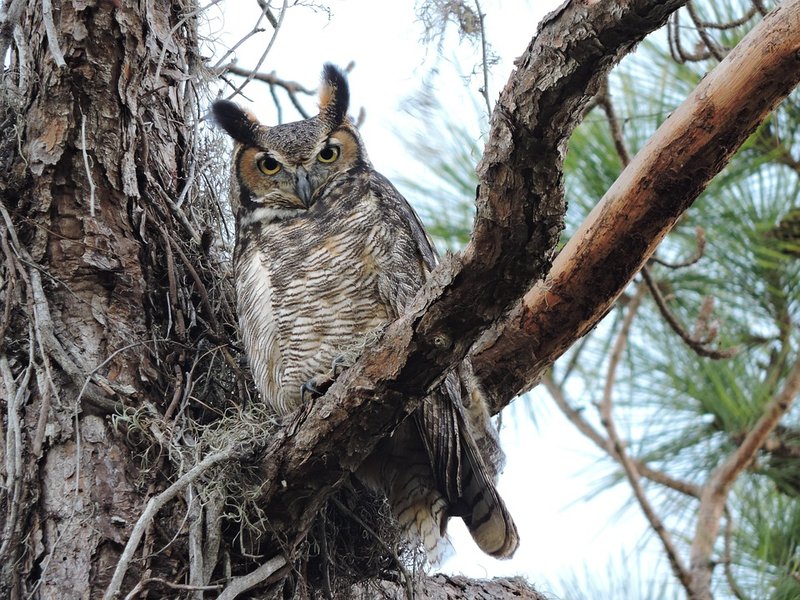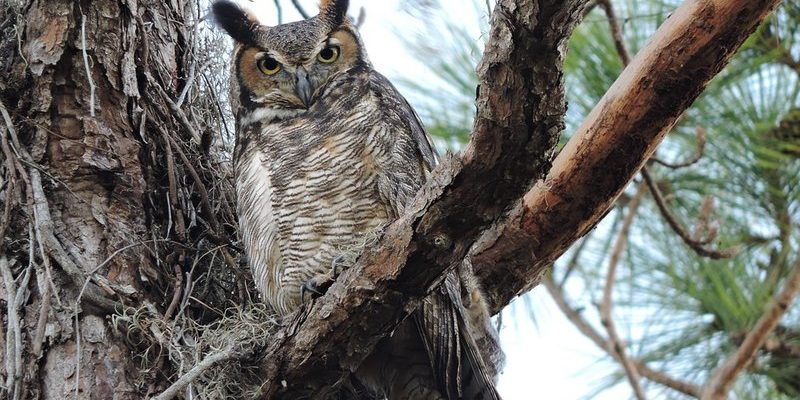
The Great Horned Owl is one of the most recognizable owls in North America. With its tufted “horns” and striking yellow eyes, it embodies the mystery and majesty of the night. Imagine wandering through a quiet forest at dusk, only to hear the unmistakable hoot of this incredible bird. It’s more than just a sound; it’s a reminder that nature is alive and full of wonders.
These owls are not just pretty to look at; they play an essential role in their ecosystem. They’re fierce predators, capable of taking down animals much larger than themselves. But there’s so much more to the Great Horned Owl than meets the eye. If you’ve ever been curious about where they live, what they eat, and how they’ve adapted to their environment, you’re in for a treat. Let’s dive deeper into the world of this powerful nocturnal bird.
Physical Characteristics
The Great Horned Owl is known for its impressive size and distinct features. Adults can weigh between 2 to 5.5 kilograms and stand about 45 to 63 centimeters tall. Their wingspan can reach up to 1.5 meters, making them one of the largest owls in North America. The feathered tufts on their heads, which resemble horns, are often the first thing people notice. These “ear tufts” do not aid in hearing but are used for communication and display purposes.
One interesting aspect of their appearance is their eye color. The Great Horned Owl has bright yellow eyes that appear almost glowing in the dark. This feature helps them see exceptionally well at night. Their feathers are primarily mottled brown, gray, and white, providing excellent camouflage against tree bark and foliage. This helps them stay hidden from both prey and potential threats during the daytime.
Comparative Features
| Aspect | Details |
| Height | 45 to 63 cm |
| Wingspan | Up to 1.5 m |
| Weight | 2 to 5.5 kg |
| Coloration | Browns, grays, and whites |
| Eye Color | Bright yellow |
Habitat and Range
Great Horned Owls are incredibly adaptable birds, able to thrive in a variety of environments. They can be found in forests, deserts, mountains, and even urban areas. This adaptability helps them locate food sources and nesting sites in diverse locations. They prefer areas with tall trees, where they can easily hunt and perch while keeping an eye on their surroundings.
In North America, their range stretches from the Arctic tundra to the southern tip of South America. This wide distribution shows their remarkable ability to adjust to different climates and conditions. You might spot them in the woods behind your home, perched on a telephone pole, or even nesting in an abandoned building. They’re quite resourceful and make use of whatever environment is available.
Migration Patterns
Unlike many birds, Great Horned Owls are mostly non-migratory. Some individuals may move to find more favorable hunting conditions, but generally, they stay close to their territory year-round. Their strong territorial instinct means they occupy and defend specific areas that provide ample resources for hunting and nesting.
Diet and Hunting Behavior
These owls are skilled predators, known for their varied diet. They primarily hunt small mammals, such as rabbits and rodents, but their menu can include birds, reptiles, and even insects. What makes them unique is their ability to take down prey that is much larger than themselves, sometimes even foxes or young deer!
Great Horned Owls rely on stealth and surprise during hunting. They are mostly nocturnal, which means they do the majority of their hunting at night. With their exceptional night vision and keen hearing, they can locate prey in total darkness. Once they spot a target, they swoop down silently, using their strong talons to catch and immobilize it. This hunting technique is not just impressive; it’s crucial for their survival.
Feeding Habits
After catching their prey, the Great Horned Owl usually devours it whole if it’s small enough. If the meal is larger, they might tear it apart with their beak. Interestingly, these owls regurgitate pellets containing undigested parts, such as bones and fur. This behavior helps them digest their food more efficiently, and those pellets can often be found beneath their perches. They serve as essential indicators of the owl’s diet and can even be collected for study by wildlife enthusiasts.
Breeding and Nesting
The breeding season for the Great Horned Owl typically begins in late winter. These owls are monogamous, often forming lifelong bonds with a single mate. During courtship, males display their impressive flying skills and produce distinct calls to attract females. Once paired, they will find a suitable nesting site, which can range from tree cavities to old nests abandoned by other birds.
The female usually lays about two to four eggs, which she incubates for about 30 to 37 days. During this period, the male takes on the responsibility of hunting and bringing food to the female. After the chicks hatch, they are covered in fluffy down feathers and rely on their parents for food and protection. The young owls will remain in the nest for about six weeks before they start to explore their surroundings.
Parental Care
Both parents are involved in raising their young. The male continues to bring food even after the chicks leave the nest, helping them learn to hunt. This extended parental care is critical since young owls need time to develop their skills before they can fend for themselves. Generally, by the fall, the young owls will have learned enough to start hunting independently, marking their transition into adulthood.
Conservation Status
The Great Horned Owl is currently classified as a species of least concern by the IUCN. Their adaptability and wide range have helped them maintain stable populations. However, they still face threats from habitat destruction and environmental changes. Urbanization can lead to fewer hunting grounds, putting pressure on local populations.
Conservation efforts focus on preserving natural habitats and raising awareness about the importance of these magnificent birds. By educating the public and promoting responsible land use, we can help ensure that Great Horned Owls continue to thrive for generations to come.
Importance in Ecosystems
Great Horned Owls play a vital role in controlling populations of rodents and other small mammals. By keeping these populations in check, they help maintain a balanced ecosystem. This predator-prey relationship is crucial for the health of various habitats, ensuring that no species becomes overabundant and disrupts the natural order.
Unique Behaviors and Traits
One of the most fascinating aspects of the Great Horned Owl is its vocalizations. They have a deep, resonant hoot that can carry for miles. This call serves multiple purposes, from establishing territory to communicating with their mate. Another intriguing behavior is their adaptability in hunting techniques. They can hunt not only in forests but also in open fields, demonstrating their varied skillset.
During the day, you might find them resting on a high branch, blending in with their surroundings. Their incredible camouflage allows them to remain undetected by both prey and predators. If threatened, they can puff up their feathers to appear larger and more intimidating, a clever tactic to ward off potential threats.
Cultural Significance
Throughout history, the Great Horned Owl has held various meanings in different cultures. In many Native American traditions, they are seen as symbols of wisdom and protection. Their mysterious nature has led to countless myths and stories, often portraying them as guardians of the night. This cultural significance adds another layer to their fascinating persona, reminding us of the deep connections between humans and wildlife.
FAQ
What is the lifespan of a Great Horned Owl?
In the wild, Great Horned Owls typically live around 10 to 15 years. However, some individuals can live longer in captivity, often reaching up to 25 years. Their longevity can be affected by factors like diet, habitat, and threats from other animals.
Do Great Horned Owls migrate?
Generally, Great Horned Owls are non-migratory birds. They tend to stay within their territory year-round, unless food becomes scarce or environmental conditions change drastically. During particularly harsh winters, some may move to find better hunting opportunities.
What do Great Horned Owls eat?
Their diet primarily consists of small mammals like rabbits and rodents, but they are highly adaptable hunters. They can also consume birds, reptiles, and insects. This varied diet allows them to thrive in different environments and locations.
How can you identify a Great Horned Owl?
Look for their distinct features: the tufted “horns,” bright yellow eyes, and robust size. They typically have mottled brown and gray plumage that helps them blend into their surroundings, especially during the day.
Are Great Horned Owls dangerous?
While they are powerful predators, Great Horned Owls are not dangerous to humans. They will usually avoid contact with people. However, like any wild animal, they can become aggressive if they feel threatened, especially if they have young chicks nearby.
Where do Great Horned Owls nest?
These owls can nest in various locations, including tall trees, cliffs, and abandoned nests of other large birds. They often choose secluded spots that provide safety for their young while still offering a good view for hunting.
Do Great Horned Owls have any natural predators?
Adult Great Horned Owls are at the top of the food chain, but they can occasionally fall prey to larger birds of prey or other animals that threaten their nests. Young owls are more vulnerable and can be at risk from hawks and other carnivorous birds.
How do Great Horned Owls communicate?
They communicate through a series of vocalizations, the most famous being their deep hooting sound. These calls can signify territory and attract mates. They also use body language and posturing to communicate with each other, particularly during the breeding season.
What are the biggest threats to Great Horned Owls?
Habitat loss due to urbanization and deforestation poses a significant threat to Great Horned Owls. Additionally, collisions with vehicles and exposure to pesticides can impact their populations. Conservation efforts aim to protect their habitats and raise awareness about these issues.
Can Great Horned Owls see in complete darkness?
While they have excellent night vision, they cannot see in complete darkness. However, their eyes are highly sensitive to low light, allowing them to see well at dusk and dawn, which are prime hunting times.

